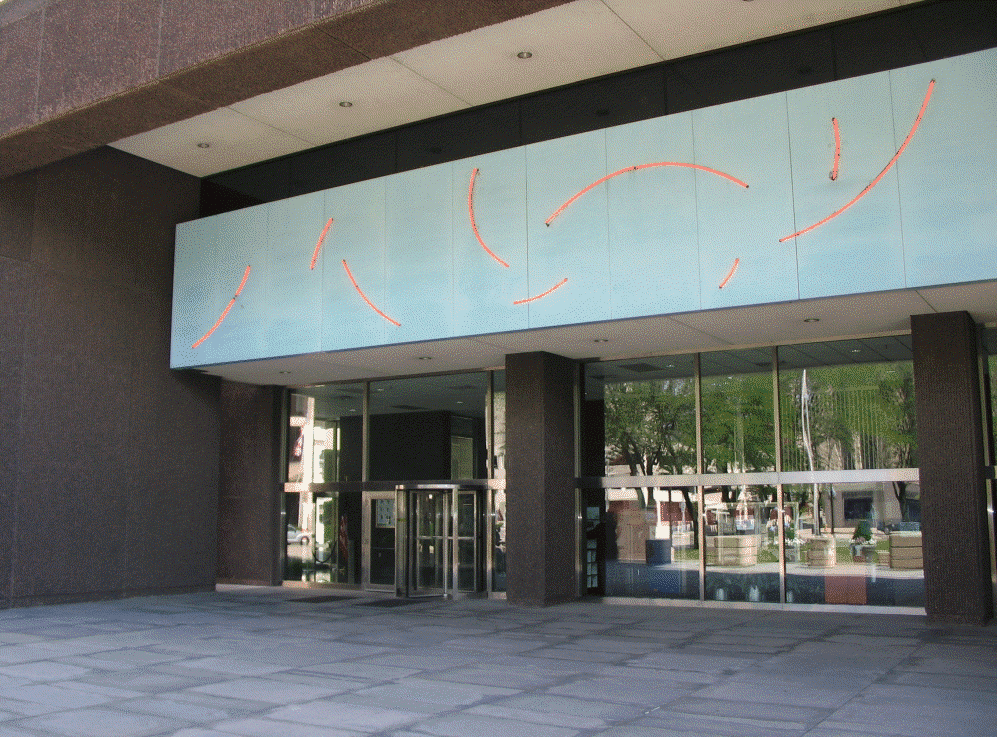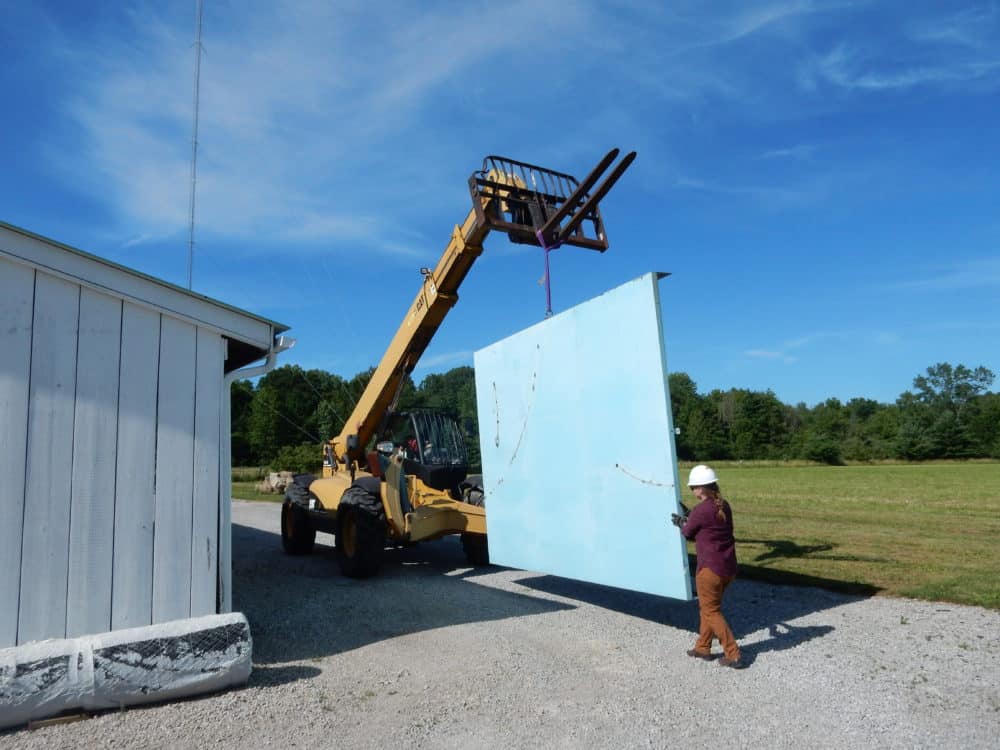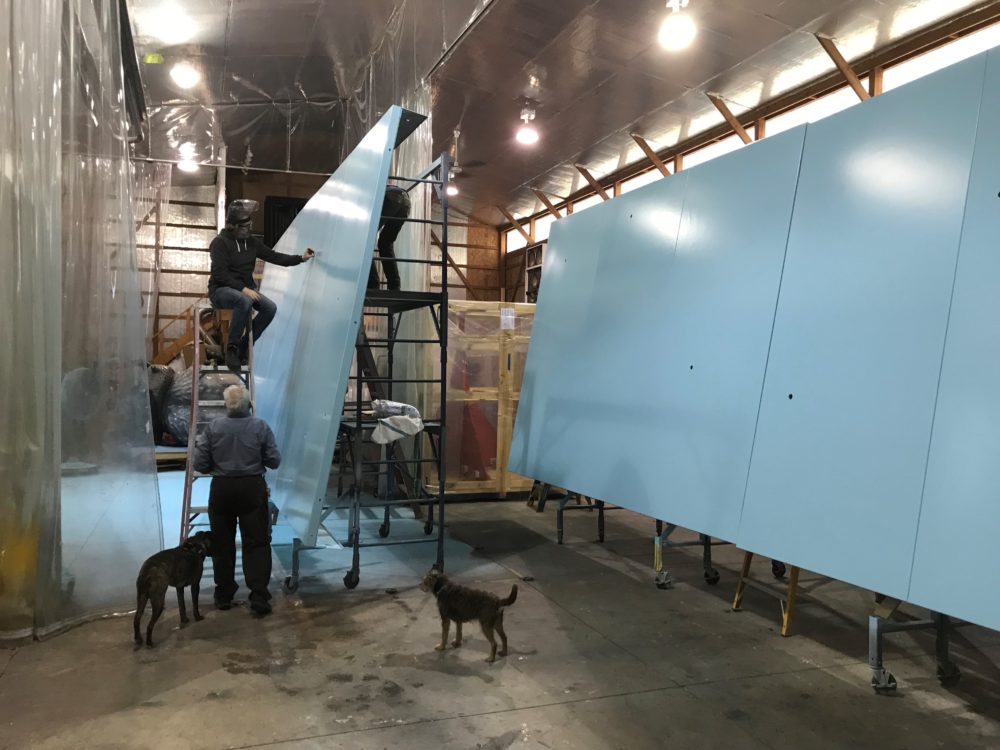Public Art Conservation, Outdoor Sculpture Conservation:

Sometimes conservation treatment projects are so large, they must be completed in phases. This is the case for the public art conservation treatment of Red Neon Circle Fragments on a Blue Wall, 1978 by artist Stephen Antonakos. At the time of installation in the late 1970s, the sculpture featured several large aluminum panels painted a saturated light blue color. The large panels were installed next to one another to create the appearance of a long wall. Interspersed along the blue wall were slightly bent neon tubes of varying lengths which fluoresced a red color when illuminated.

The artwork was nestled above the entrance of the Federal Building and U.S. Courthouse in Dayton, Ohio, but after several decades it was in need of repair. The need for the public art conservation treatment was, however, not “out of the blue” since sculpture has been installed for many years outdoors. By the end of 2017, the paint was faded and chalked in appearance, no longer a rich, uniform blue color. The neon tubes also no longer functioned as intended and required replacement.
Since the time of the installation of the sculpture, building and electrical codes also changed. But there was no way to readily access the back of the panels to administer these types of repairs since adequate rear-entry was not considered in the original design. For the upcoming 2017-2018 conservation treatment by McKay Lodge Conservation, not only did the panels need recoating and the electrical components updated, but a new structure design was necessary so that panels could be easily accessed for future repairs.

Once the scope of work was determined and addressed, the first major phase was mapping out the locations of the neon tubes and deinstalling the artwork from the building. The conservation team was assembled to remove the sculpture from its location in Dayton, which required some heavy duty equipment, safety concerns, and sidewalk closures. Before desintallation of the panels, the position and size of the neon tubing was mapped by City Lights Neon, and the failed components were removed.
For the panel disassembly, two lifts were first positioned on either side of the panel to be removed. A spider crane was then used to lift the panel. Once the panel was removed, conservators on each side then guided it to the ground so it could be packed for transport. These steps were repeated until the entire sculpture was deinstalled from above the entrance of the building.


The next major phase was stripping and recoating Red Neon Circle Fragments on a Blue Wall. For this stage, the artwork journeyed to our conservation facilities in Oberlin, Ohio. Due to its large size and location on the outskirts of Cleveland, the McKay Lodge Conservation lab is capable of handling, treating and storing large sculpture in its secure lab and outbuilding facilities.
Once the panels arrived, the previous, failing coatings were removed. The former paint was removed with chemical stripping because it was determined to be the safest and best method. McKay Lodge Conservation is uniquely suited to preform media blasting, chemical or manual stripping, and application of high-performance coatings. The ability to provide these kinds of services on-site allows us to offer affordable conservation treatment of painted outdoor sculpture and other painted works of art.

At this point, previous failing repairs to the metal panels were removed and new repairs were welded and filled as needed. After stripping and panel repairs, the aluminum surface was treated so that the metal was clean and prepared for a coating of paint. The color was matched to the original blue color as much as possible. An even, cohesive layer was applied by Emmett Lodge, a seasoned applicator and NACE certified coatings inspector. The final coat was measured to ensure a proper dry film thickness (DFT) according to the manufacturer’s specifications.


Panels were then installed into a temporary storage location until the next phases can begin. Please check back later this year for the treatment progress and completion.
